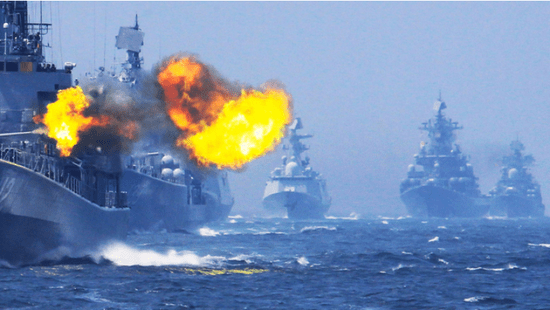According to media reports, the southern Russian Military Region announced on the 10th that the Russian navy will participate in an anti-piracy military exercise next year.
If it is held, it will be the first time since 2011 that Russia has conducted military exercises with multiple NATO members. However, NATO said that the organization “has no plan to conduct exercises with Russia” and whether member states participate depends on themselves.
“The same frame” for the first time in nearly a decade?
The Russian Navy will participate in the “Aman-2021” military exercise scheduled for February 2021 in the Pakistani port city of Karachi, Russia’s Southern Military Region said in a statement on the 10th. A total of 30 countries will participate in the exercise, of which 10 countries will send fleets and the rest will send observers.
The purpose of the exercise is to “strengthen and develop military cooperation between participating countries” and to exchange experience in “combat the piracy threat in areas with dense shipping”.
The Russian News Agency quoted a statement from the Russian Black Sea Fleet as saying that the participating countries included Russia, Pakistan, China and Japan.
The statement also said that NATO countries such as Britain, the United States and Turkey will also send fleets to participate. The Russian Black Sea Fleet will represent Russia in the exercise, and the Russian navy will send frigates, cruisers, marines and helicopter troops to participate.
Tass reported that the last exercise of the Russian navy with several NATO members dates back to the “Bold Monarch” exercise held near the Spanish coast in 2011. Since then, Russia has not conducted military exercises with many NATO countries, but has conducted many exercises with Turkey alone.
However, a NATO official said that NATO itself “has no plan to conduct exercises with Russia” and that the participation of various countries depends on their decisions. “Our pragmatic cooperation remains on hold due to Russia’s illegal annexation of Crimea in 2014,” said NATO spokesman Lenjesku.
Russia and NATO show each other’s muscles
The different wording of the military exercise arrangements between Russia and NATO is thought-provoking, and the relationship between the two sides has been tense in recent years.
Nearly 30 years after the cold war, the foundation of political mutual trust between Russia and NATO is still weak, and military mutual trust is even more “mirrential”. Recently, a series of events have damaged the already seriously inadequate military mutual trust between the two sides.
On November 30, Russian Vice Foreign Minister Riabkov, who is responsible for the control negotiations on the U.S. military, condemned that NATO should stop the so-called “joint nuclear mission”, because it will not only affect regional stability, but also directly violate the provisions of Articles 1 and 2 of the Treaty on the Non-Proliferation of Nuclear Weapons.
NATO’s so-called “joint nuclear mission” is the deployment of nuclear weapons by non-nuclear countries in NATO member states. This aspect will increase NATO’s nuclear deterrence, but at the same time, it will also put those non-nuclear countries that deploy nuclear weapons under the reciprocity threat.
In the “NATO 2030” report released earlier this month, there is a sentence: Russia may still be the main threat to NATO in the next 10 years. The report proposes to strengthen NATO’s ability to counter the Russian threat. This document will be presented to NATO leaders at the NATO summit planned for next year.
Accordingly, Russia has constantly warned its opponents by “showing off its muscles”.
The Moscow Times reported on the 7th that Russia hopes to expand its military strength in Kaliningrad as NATO gathers troops near the border of Russia’s Baltic enclave. Alexander Nosatov, commander of the Russian Baltic Fleet, accused Western countries of deploying an armored tank and tactical teams of several battalions on the border of the enclave, “to deal with this threat, the armed forces leaders were forced to take retaliatory measures.” Kaliningrad borders NATO member Poland and Lithuania and is the seat of the Russian Baltic Fleet.
According to NBC, the Russian army conducted a comprehensive strategic nuclear force exercise on the 9th, including several missile tests. The Russian Ministry of Defense said in a statement that the exercise included the test firing of an intercontinental ballistic missile from the nuclear submarine Karelia in the Barents Sea.
Some American media pointed out that during Trump’s four years in power, it provided space for Russia to make diplomatic progress.
In Syria, the Russian Navy has a mature naval base in Tartus on the Mediterranean coast and an advanced air base in Khmetham. Although this is a small achievement compared with the United States, it still represents an unprecedented strategic expansion of Russia’s existing military capabilities.
In 2018, Russia also reached an agreement with Israel and Syria to deploy Russian troops and observation points in the Golan Heights for the first time. Neither Washington nor Israel would support such a move during the Cold War, but Washington remained silent in this incident.
Russia is also expanding its strength in Sudan.
At the end of November 2020, Russian President Putin approved the establishment of a Russian naval material support point in Sudan, becoming the first Russian naval base in Africa after the collapse of the Soviet Union, and the second Russian naval base outside the Soviet Union after the Syrian Tartus naval base.
In addition, during the karabakh conflict, Russia established a power-guest role and deployed military forces to consolidate its new position.
At present, as the U.S. government is about to change its term, there is a focus on President-elect Biden’s strategy against Russia. How to deal with Russia will be a challenge for him.



